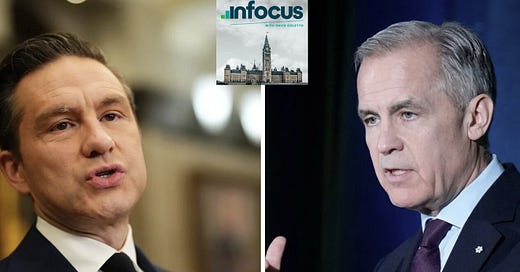Carney vs. Poilievre: Unpacking Public Perceptions
What Canadians think about both leaders and what that means for what happens next.
Canada is on the cusp of a federal election featuring two relatively fresh faces: Prime Minister Mark Carney, newly at the helm of the Liberal Party, and Pierre Poilievre leading the Conservatives. While both men arrive with distinct backgrounds and approaches, their contest appears to be shaping up as a close one. Recent survey findings underscore just how narrow the race could be, shedding light on each leader’s perceived strengths, vulnerabilities, and the sentiments driving voter intention.
Methodology and Approach
On our most recent national survey, I designed a new set of questions to gauge perceptions of both Carney and Poilievre. I explored perceptions of their backgrounds, character traits, and perceived policy orientations—and asked respondents to indicate whether they believed each statement to be true or false. We then asked whether they considered that characteristic or quality a “good thing” or a “bad thing”, if it was true. This dual-layered approach was intended to capture not only the prevalence of each perception (the extent to which it is believed) but also the valence or directional impact (how voters react emotionally and evaluatively to that attribute). By structuring the survey this way, we aimed to gauge both the factual and the attitudinal dynamics underpinning how Canadians view these leaders, providing deeper insights into how such beliefs could influence vote choice and broader political sentiment.
Several notable data points emerged:
Mark Carney’s Continuity vs. Economic Expertise
56% of Canadians think Carney will continue many of Justin Trudeau’s policies; among those holding this view, 57% say that’s a “bad thing.”
60% of Canadians believe Carney “understands how to run an economy,” and over 70% of that group see that quality as a good thing.
46% say Carney has considerable crisis-management experience; two-thirds who believe this see it positively.
Pierre Poilievre’s Distinct Direction vs. Likability Gap
71% think Poilievre is poised to take the country in a “very different direction” from the Liberals; 53% of those believe this difference is good.
49% say Poilievre “understands how tough things are and will do whatever he can to make life better,” and 69% of that group approve of that trait.
Only 17% of Canadians find it definitely true that Poilievre is “friendly and kind.”
Both Leaders Neck-and-Neck on ‘Best Person to Lead’
Carney and Poilievre receive roughly the same overall percentage of Canadians saying each is the best to lead the moment Canada faces.
15% of Canadians actually believe both men could be that leader. Among this subset, the current vote intention is 43% Liberal, 28% Conservative, 13% NDP, and 8% Bloc Québécois.
Voters Open to Supporting Either Liberal or Conservative
16% of Canadians indicate they are open to voting either Liberal or Conservative. Their perceptions of Carney and Poilievre could ultimately be decisive in a tight race.
Taken together, these figures present a picture of a highly competitive election, where both Carney and Poilievre start with distinct advantages but also face clear obstacles. Below is a closer look at what each of these findings may mean as the country edges towards its next ballot.
Carney: Balancing Trudeau’s Legacy with His Own Economic Credentials
The data shows a tension in public perceptions of Mark Carney. On one hand, a strong majority acknowledges his economic expertise:




